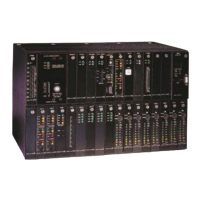Chapter 1. System Overview and Modes of Operation
6
Serial Line Internet Protocol (SLIP)
A D/I Mux III with the SNMP option will usually be connected through a Local Area Network (LAN) to one
or more SNMP managers. The network connection can be made either through an Ethernet 10Base-T,
or serial port connection.
A direct Ethernet connection is preferred. This is accomplished by connecting the 10Base-T jack,
located on the AMCU front panel, to a hub or other suitable network device with an appropriate cable.
If a direct Ethernet connection is not feasible, the Serial Line Internet Protocol (SLIP) connection can be
used. A serial connection is accomplished by linking the SLIP/PPP jack on the AMCU front panel to a
router or other suitable network device by any means appropriate for a serial connection. The router
must be configured for a SLIP connection.
While a serial network connection is significantly slower than an Ethernet connection, it is more flexible.
The serial link can be carried by a D/I Mux Subrate Data Multiplexer (SDM) channel, or in any of a
number of other ways in addition to a direct cable connection.
While it is possible to use both the Ethernet and SLIP/PPP ports simultaneously, this is usually not done
because the AMCU card has no internal bridging or routing capabilities. Additionally, the SLIP feature
does not currently support the use of modems.
Figure 1-5 depicts SLIP operation with a network manager sending message traffic through a router, via
RS-232 cabling, and through an SDM or other transport medium, to the SLIP COM port of a far-end D/I
Mux.
Figure 1-5. Serial Line Internet Protocol (SLIP) Connection

